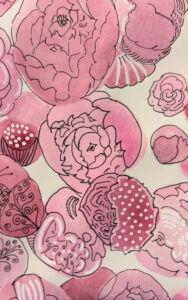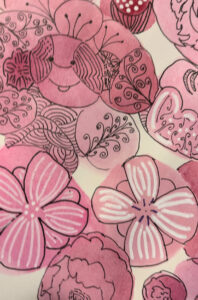Why Art as Therapy?
“What you learn today, for no reason at all, will help you discover all the wonderful secrets of tomorrow.” — Norton Juster, Author
Since the beginning of time, people have made art as a way to express themselves without words. Oftentimes, this process is easier than naming emotions and articulating how one feels to work through difficult memories or current circumstances.
All art types are powerful forms of communication. But visual arts are accessible to all; formal training is not required to create art. The marks created on the page come from the creator. Those are unique marks – there will never be another set of marks like that. They belong to the artist and the artist alone. This realization gives meaning to the work being created, to the person creating the art.
Completing a creation of art can bring feelings of accomplishment, empowerment, and satisfaction. Talking about our artwork allows us to process our emotions felt along the way and thus increases our self-awareness.
Art therapy engages the transformative process of becoming who we are. Stronger, clear-minded, centered, and value-driven.
Art therapy has been shown to improve cognition, self-awareness, and self-esteem. It increases coping and social skills and promotes self-reflection and processing. The process of making art can, in its most basic form, alleviate emotional distress, reduce anxiety and depression, and provide a way for us to tap into our deepest emotions and perceptions.
Many people find creating art to be relaxing, and studies have shown that art-making lowers heart rate and reduces stress and anxiety. Creating art has been scientifically proven to increase brain levels of serotonin, the hormone associated with leveling and controlling our moods.

Creating art with a trained therapist allows us to recall and reframe past traumas and work through feelings of shame, regret, grief, and loss. This is catharsis, a cleansing or purging, the discharge of strong emotions for relief. Talking about what the participant has created using their marks, images, journaling, and collages is cathartic.
Art therapy can help us identify what causes our emotional stress and develop constructive ways of dealing with it. By exploring these emotions, a person is able to reconcile their trauma and process their life experiences.
Art therapy is described as “drawing from within” and asks the participant to explore their inner experience. With skillfully guided workshops, the facilitator asks thoughtful questions that allow one to work through difficult emotions, sensations, and explore their ideas and perceptions of the world around them. This assists with working to get past feeling stuck and experience new growth, a more balanced mindset, and brings personal fulfillment – creating a path to improved self-worth. Guided facilitation is key to the therapeutic process.

In my workshops we work through a series of art projects. A sampling:
- Drawing from Within
- Spontaneous Art using Imagery
- Drawing on Loss, Grief, Shame, Guilt, and Anger
- Working Through Anxiety and Depression with Neurographic Art
- Setting Intentions and Rounding Off Obstacles to Our Goals
- Incorporating Nature, Micro-journaling in Collage Making
- Creating a Picture of Health and Well Being, and more
Examples of popular workshops:
 Mindfulness Journaling, an ongoing project to capture growth and mindset change. Using art therapy exercises we will explore creating our own naturally stained watercolor paper, work with a variety of page sizes from 2” squares for collage assemblage, to a full sheet of washes, to organic shapes and designs. We will create a series of pages using mindfulness pattern work over watercolor washes. We will incorporate micro-journaling using a variety of paint pens and fine-tipped markers, pencils and other marking instruments. We will explore with poetry passages, song lyrics, and inspiring messages of hope. Throughout this process we will discuss why hope is the core of our existence, how we will nurture it and allow it to grow within us. We will discuss shame, vulnerability, and trust as we create visual pieces to work through our experiences.
Mindfulness Journaling, an ongoing project to capture growth and mindset change. Using art therapy exercises we will explore creating our own naturally stained watercolor paper, work with a variety of page sizes from 2” squares for collage assemblage, to a full sheet of washes, to organic shapes and designs. We will create a series of pages using mindfulness pattern work over watercolor washes. We will incorporate micro-journaling using a variety of paint pens and fine-tipped markers, pencils and other marking instruments. We will explore with poetry passages, song lyrics, and inspiring messages of hope. Throughout this process we will discuss why hope is the core of our existence, how we will nurture it and allow it to grow within us. We will discuss shame, vulnerability, and trust as we create visual pieces to work through our experiences.
A Safe Place, an anxiety-reducing exercise. Creating a safe place can assist with reducing stress associated with triggers, anxiety, and relived trauma. The drawing can be used as a visual image to calm when the need arises. Creating a safe place allows one to relax and brings a sense of serenity. To begin we spend some time thinking of our ideal safe place. It could be the beach, a treehouse, inside the arms of a loved one, or even a fantasy realm. On paper, use a variety of mediums to depict your own unique image of a safe place. Add details and colors that bring the most personally calming effect. Discussion questions will address identifying how our senses help us to determine safety or danger. What does your safe place look like? Smell like? Feel like? Is there soft music playing or distant ocean breezes? What do you hear? What other tools can we use when triggered to feel safe? Meditation, talking to a friend, writing in your journal, etc.
Mandalas, a creative exercise that brings stress relief, meditation skills, and mindfulness. Mandala is the Sanskrit word for circle. In Eastern tradition, it is used as a meditation tool. Through creating our own unique mandala, we use mindfulness and the act of meditation and relaxation. Mandalas incorporate pattern work that is created intuitively and creates a cohesive design. This workshop takes about one hour to complete, and in that span of art-making, cortisol levels drop. Cortisol has been shown to have a direct correlation with decreasing levels of stress, thus the meditative quality of this workshop. Mandalas are beautiful works of art, sometimes simple and other times ornate. Each one is unique to its creator and a reflection of the story of the artist. Discussion questions may include if the participant was able to relax and reach a state of meditative “flow”. Briefly describe the story behind your artwork. Why did you choose the colors used? Do they bring you peace or joy?
To discuss these workshops and others offered by Wendie Appel, please reach out using the contact form here.


